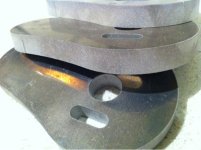This thread is so I'm not tempted to clutter up Recumpence's thread about his awesome new belt drive for the KMX trike.
Here's my background: I made a series of small 3" dia epoxy pulleys to use a timing belt I got from a surplus store. The teeth stripped off. I believe that this was due to too much stress per tooth. I should have made the pulley much, much larger. The molding went well, with very little mess providing that I bulked up the epoxy with some filler (colloidal silica from West System).
Another member, E-Racer, has had better luck, ie, no teeth stripping provided the pulleys/cogs were 6" diameter or larger.
It appears from AussieJester's build log for his HXT chopper: http://endless-sphere.com/forums/viewtopic.php?f=28&t=12810&start=300
That he also tried it out. I didn't follow the thread long enough (104 pages) to figure out what happened with that effort.
Did he end up using them? If not, why?
I'm keen to figure some of this stuff out. Anybody want to show me how to calculate loading per tooth?
This method seems like it would work, and be fairly easy to try out.
Other options, castable urethane comes to mind.
Katou
Here's my background: I made a series of small 3" dia epoxy pulleys to use a timing belt I got from a surplus store. The teeth stripped off. I believe that this was due to too much stress per tooth. I should have made the pulley much, much larger. The molding went well, with very little mess providing that I bulked up the epoxy with some filler (colloidal silica from West System).
Another member, E-Racer, has had better luck, ie, no teeth stripping provided the pulleys/cogs were 6" diameter or larger.
It appears from AussieJester's build log for his HXT chopper: http://endless-sphere.com/forums/viewtopic.php?f=28&t=12810&start=300
That he also tried it out. I didn't follow the thread long enough (104 pages) to figure out what happened with that effort.
Did he end up using them? If not, why?
I'm keen to figure some of this stuff out. Anybody want to show me how to calculate loading per tooth?
This method seems like it would work, and be fairly easy to try out.
Other options, castable urethane comes to mind.
Katou








